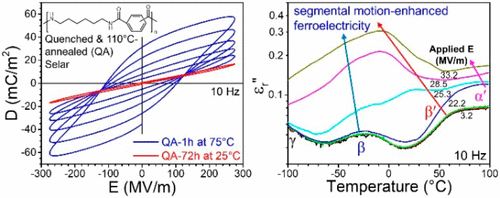当前位置:
X-MOL 学术
›
Macromolecules
›
论文详情
Our official English website, www.x-mol.net, welcomes your feedback! (Note: you will need to create a separate account there.)
Nature of Ferroelectric Behavior in Main-Chain Dipolar Glass Nylons: Cooperative Segmental Motion Induced by High Poling Electric Field
Macromolecules ( IF 5.5 ) Pub Date : 2018-02-26 00:00:00 , DOI: 10.1021/acs.macromol.7b02719 Zhongbo Zhang 1 , Morton H. Litt 1 , Lei Zhu 1
Macromolecules ( IF 5.5 ) Pub Date : 2018-02-26 00:00:00 , DOI: 10.1021/acs.macromol.7b02719 Zhongbo Zhang 1 , Morton H. Litt 1 , Lei Zhu 1
Affiliation

|
Main-chain dipolar glass polymers such as aromatic nylons are promising for high energy density and low loss dielectric applications because of the limited, noncooperative oscillation of highly dipolar amide groups. However, quenched aromatic nylons have been reported to exhibit significant ferroelectric switching upon high field poling. It is desirable to suppress ferroelectric switching for electric energy storage application, and this requires a fundamental understanding of the nature of ferroelectric behavior in dipolar glass nylons. In this work, a nearly 100% amorphous aromatic nylon, Selar, was used to investigate the origin of ferroelectricity in glassy nylons. Using Fourier transform infrared spectroscopy, it was found that hydrogen-bonding strength played an important role in the ferroelectric switching of amide dipoles in the loosely packed glassy matrix. When hydrogen bonding was weak such as in the quenched film, significant ferroelectric switching took place. In contrast, quenched and annealed films did not exhibit any ferroelectric switching. High-voltage broadband dielectric spectroscopy was used to study molecular and segmental motions in Selar. It was observed that the primary contribution to ferroelectric switching came from cooperative segmental motions (i.e., a combination of various sub-Tg relaxations, where Tg is the glass transition temperature) in the main-chain dipolar glass nylon. This understanding will help us design new aromatic nylons with suppressed segmental motions for high energy density and low loss dielectric applications.
中文翻译:

主链偶极玻璃尼龙中铁电行为的性质:高极化电场引起的协同节段运动
主链偶极玻璃聚合物(如芳族尼龙)因高偶极酰胺基团的有限,非合作性振荡而有望用于高能量密度和低损耗的介电应用。然而,据报道,淬火的芳族尼龙在高电场极化时表现出明显的铁电转换。理想的是抑制用于电能存储应用的铁电开关,这需要对偶极玻璃尼龙中铁电行为的性质有基本的了解。在这项工作中,将近100%的非晶态芳香族尼龙Selar用于研究玻璃态尼龙中铁电的起源。使用傅立叶变换红外光谱,发现氢键强度在松散堆积的玻璃状基质中酰胺偶极子的铁电转换中起重要作用。当氢键很弱时,例如在淬火膜中,发生了明显的铁电转换。相反,淬火和退火的膜没有任何铁电转换。高压宽带介电谱用于研究Selar中的分子运动和分段运动。据观察,铁电开关的主要贡献来自于协同分段运动(即,各种子运动的组合)。高压宽带介电谱用于研究Selar中的分子运动和分段运动。据观察,铁电开关的主要贡献来自于协同分段运动(即,各种子运动的组合)。高压宽带介电谱用于研究Selar中的分子运动和分段运动。据观察,铁电开关的主要贡献来自于协同分段运动(即,各种子运动的组合)。T g弛豫,其中T g是主链偶极玻璃尼龙中的玻璃化转变温度。这种理解将帮助我们设计出抑制了分段运动的新型芳香族尼龙,以实现高能量密度和低损耗的介电应用。
更新日期:2018-02-26
中文翻译:

主链偶极玻璃尼龙中铁电行为的性质:高极化电场引起的协同节段运动
主链偶极玻璃聚合物(如芳族尼龙)因高偶极酰胺基团的有限,非合作性振荡而有望用于高能量密度和低损耗的介电应用。然而,据报道,淬火的芳族尼龙在高电场极化时表现出明显的铁电转换。理想的是抑制用于电能存储应用的铁电开关,这需要对偶极玻璃尼龙中铁电行为的性质有基本的了解。在这项工作中,将近100%的非晶态芳香族尼龙Selar用于研究玻璃态尼龙中铁电的起源。使用傅立叶变换红外光谱,发现氢键强度在松散堆积的玻璃状基质中酰胺偶极子的铁电转换中起重要作用。当氢键很弱时,例如在淬火膜中,发生了明显的铁电转换。相反,淬火和退火的膜没有任何铁电转换。高压宽带介电谱用于研究Selar中的分子运动和分段运动。据观察,铁电开关的主要贡献来自于协同分段运动(即,各种子运动的组合)。高压宽带介电谱用于研究Selar中的分子运动和分段运动。据观察,铁电开关的主要贡献来自于协同分段运动(即,各种子运动的组合)。高压宽带介电谱用于研究Selar中的分子运动和分段运动。据观察,铁电开关的主要贡献来自于协同分段运动(即,各种子运动的组合)。T g弛豫,其中T g是主链偶极玻璃尼龙中的玻璃化转变温度。这种理解将帮助我们设计出抑制了分段运动的新型芳香族尼龙,以实现高能量密度和低损耗的介电应用。



























 京公网安备 11010802027423号
京公网安备 11010802027423号